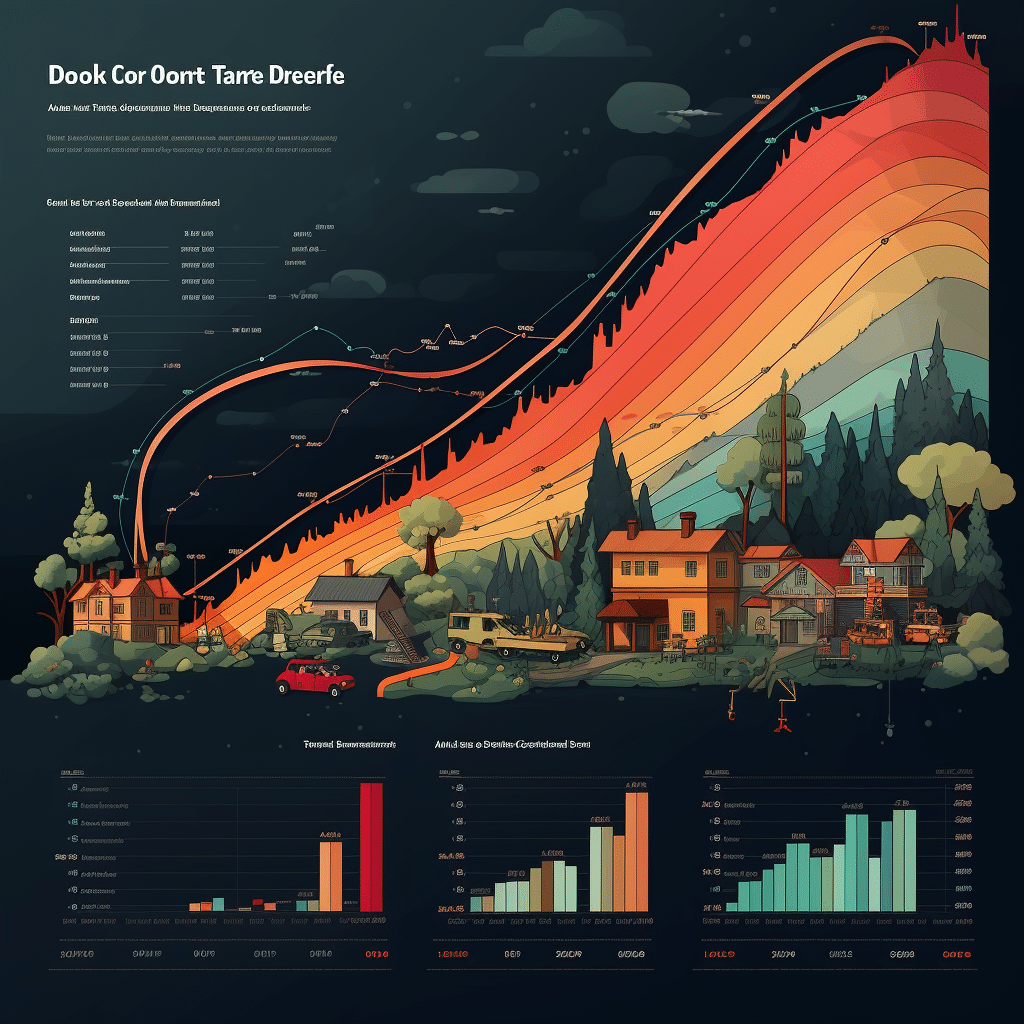Understanding the Importance of Your Debt-to-Income Ratio
Definition of Debt-to-Income (DTI) Ratio and Its Significance in Lending
Hold onto your hats, because we’re about to dive into the financial term that could make or break your next credit application – the debt-to-income (DTI) ratio. If you’ve ever felt the excitement of house hunting or the thrill of dreaming up big purchase plans, you know that your DTI ratio is the financial pulse that lenders check. In essence, it’s the slice of your pie chart that tells lenders, “Hey, this person knows how to balance their dough!” Put simply, your DTI ratio is your monthly debt payments waved against your gross monthly income. It’s the yardstick that measures your ability to manage monthly payments and repay the money you borrow.
How Lenders Use Your DTI to Assess Your Creditworthiness
Money talks, and in the lending world, it speaks through the DTI ratio. It whispers secrets about your financial health and screams warnings if the numbers don’t line up. Lenders, including those charming folks who’ll decide on your mortgage or car loan, use DTI as a beacon to assess if you can juggle additional debt without dropping the ball. They’re looking for that sweet spot; a DTI ratio that’s below 43% is typically what they want to see. It shows you’re a smooth operator who has their finances locked down. Aim for a lower ratio, even 35% if you can, because when it comes to DTI, less is definitely more.

Expert Insight Into Using a Debt-to-Income Ratio Calculator
The Mechanics Behind DTI Calculators
Now, let’s get down to the nuts and bolts: how does a debt-to-income ratio calculator work its magic? It’s pretty straightforward – you punch in your monthly debts (think mortgages, student loans, credit card bills – the usual suspects) and then your gross monthly income. The calculator does a quick pirouette on the dance floor of mathematics and – voila! – out comes your DTI ratio. But not all calculators are created equal. Some are the equivalent of a smooth jazz band, while others might leave you listening to elevator music. So, the rhythm and beat of the calculator you choose matters.
Accuracy and Efficiency: Why Choosing the Right Calculator Matters
You want a calculator that’s more Einstein and less… well, not Einstein. A tool that combines precision with user-friendliness because accuracy in this game counts big time. The right calculator won’t just spit out a number; it’ll be your beacon in the fog, guiding you through the nuances of your financial landscape.

| Aspect | Details |
|---|---|
| Definition | DTI is the percentage of your gross monthly income that goes to paying your monthly debt payments. |
| Purpose | Assessing borrower’s ability to manage monthly payments and repay debts. |
| Calculation | Monthly Debt Payments ÷ Gross Monthly Income × 100 = DTI (%) |
| Components of Monthly Debts | Mortgage/rent, credit card payments, loan repayments (auto, student, personal), child support, etc. |
| Gross Monthly Income | Your income before taxes and other deductions. |
| Ideal DTI Ratio | ≤ 36% for better loan opportunities. |
| Maximum Acceptable DTI Ratio | ≤ 43% for Qualified Mortgages. |
| Risks of High DTI | May lead to loan rejections, higher interest rates, and financial stress. |
| Benefits of Low DTI | Better interest rates, loan terms, and easier approval for new credit. |
| DTI Ratio Categories | |
| – 50% or more: Severe risk and may need debt relief assistance | |
| Use in Lending Decisions | Part of determining creditworthiness for mortgages, auto loans, etc. |
| Improving DTI Ratio | Pay down debts, increase income, avoid taking on new debts. |
The 5 Best Debt-to-Income Ratio Calculators of 2024
Factors Considered for the Ranking: Usability, Accuracy, and Features
To dish out the crème de la crème of DTI calculators, we’ve combed through the jungle of options, looking for the tools that are a doddle to use, precise as a Swiss watch, and chock-full of useful features. We used real-life financial conundrums as our test tracks, measuring everything from the clickability of buttons to the depth of insights they provide. So, without further ado, let’s unveil the all-stars.

NerdWallet: A Comprehensive Debt to Income Calculator
NerdWallet struts onto the scene with a calculator that’s as detailed as a Renaissance painting. This isn’t your run-of-the-mill number cruncher; it’s more like having a financial advisor tucked into your browser, ready to spring into action.
This sharp tool does more than just tell you where you stand. It offers personalized advice, like how to shimmy down the DTI ladder if your ratio’s stepping on your toes. Also, considering how to refinance an investment such as a business rental property fits neatly into this picture, a nod to NerdWallet’s comprehensive touch.

Bankrate’s Precision: A Trustworthy Mortgage DTI Calculator
With Bankrate’s calculator, it’s like swapping your trusty pocket calculator for a supercomputer. It’s not content with ballpark figures; this bad boy goes for big-league precision, catering especially to mortgage shoppers.
Let’s say you’re mulling over the theme song from “Bond 25” and thinking, “Could I swing a house like Bond?” Bankrate’s calculator breaks it down for you. It factors in nuances peculiar to mortgages that make it as reliable as getting life advice from your grandma.

SmartAsset – Tailoring the Debt-to-Credit Ratio Calculator to Your Needs
Ever wished a calculator could read your mind? Welcome to SmartAsset. It adapts to your financial situation like a tailor fitting a bespoke suit, ensuring that the DTI ratio it serves up fits you just right.
It’s all about user experience here. They’ve got interactive tools that make navigating the seas of debt and income feel like cruising in a luxury yacht. Plus, you’ll find guides that are as helpful as a Swiss Army knife when you’re deep in the financial woods.
Credit Karma: Simplicity Meets Efficiency in an Income to Debt Ratio Calculator
They say simplicity is the ultimate sophistication, and Credit Karma’s DTI calculator embodies this. Its wizardry lies in how effortlessly it turns the complex into child’s play, perfect for quick calculations without the headache.
But wait, there’s more! Like finding an extra apple watch nike strap in your gym bag, Credit Karma offers a sweet bonus by letting you keep an eagle eye on your credit score – ensuring you’re always firing on all cylinders.
Investopedia’s Calculator: For the In-Depth Debt-to-Income Ratio Analysis
Investopedia swaggers in with the aura of a university professor – it’s thorough, educating you as it crunches numbers. It provides a DTI ratio dressed in a cap and gown, complete with deeper insights that can make you feel like you’re part of The Allman brothers band, perfectly in tune with your finances.
And like any good professor, it complements its teachings with a library of resources. It’s not just a calculator; it’s a financial seminar in your pocket. Whether you’re a numbers newbie or a seasoned pro, with Investopedia, every calculation is an eye-opener.
Innovative Features to Look for in a Debt-to-Income Ratio Calculator
Expect more than just division when it comes to cutting-edge DTI calculators. We’re talking about integrating with your real-time financial data, so your calculator has its finger on the pulse like a financial physician. Scenario analysis? Absolutely. It’s all about envisioning different financial paths, akin to peeking into the multiverse of your money matters.
Choosing the Right Debt-to-Income Ratio Calculator for Your Mortgage Needs
It all boils down to finding the calculator that gels with your lifestyle. Just like choosing the right cast of ‘Alert: Missing Persons Unit’ for a TV show, the right calculator can make your financial narrative a hit series.
While these nifty tools are brilliant, they’re not fortune-tellers. They work off the numbers you feed them, so ensuring your data is accurate is like hitting the right notes in a jam session – essential for a good performance.
Conclusion: Empower Your Financial Decision-Making with the Right Tools
In a nutshell, snagging the right debt-to-income ratio calculator can supercharge your quest for creditworthiness like premium fuel in a race car. From the number savvy NerdWallet to the insightful Investopedia, each contender in our top 5 brings a unique superpower to the table. With these calculators, you can dance to the beat of financial security, stride into the mortgage approval process with confidence, and make decisions that turn dreams into reality. Remember, the sweet tune of a “good” DTI ratio not only opens doors to loans and mortgages but serenades your entire financial future with opportunities. So, pick your financial maestro wisely, and let the harmony of healthy finances play on.
Unraveling the Mysteries of Your Finances with a Debt-to-Income Ratio Calculator
Ever felt like your finances are a puzzle you just can’t solve? Well, guess what? A debt-to-income ratio calculator is like that friend who whispers the answers to a crossword puzzle at a coffee shop – super helpful and always trustworthy. Let’s dive into some trivia and facts that’ll have you and your calculator joining forces like a dynamic duo!
How to Calculate Debt Ratio: Not Just a Number Game
You’d think learning how to calculate debt ratio is as straightforward as the contemporary meaning of “swiping left, but it’s got layers, like an onion… or a really good cake. Your debt-to-income (DTI) ratio isn’t a mere mash-up of numbers; it’s the financial compass that can guide you through the wilds of money management.
I live for a good DTI ratio because it can make or break your next big financial move. It’s like the apple watch nike Straps of the financial toolkit—sleek, essential, and keeps you on pace with your financial goals. Running a marathon to financial freedom? This tool helps ensure you’re not trying to sprint with weights on your ankles.
Mortgage Refinance Calculator: The Plot Twist of Homeownership
Ever watched a thriller where the cast Of alert missing Persons unit suddenly finds a clue that changes everything? That’s what a mortgage refinance calculator can do for your home loan. It’s the plot twist you didn’t know you needed! Suddenly, you’re looking at your mortgage like Bond 25 looks at a villain—time to outsmart it and emerge victorious with better rates.
Rock Your Debt Like The Allman Brothers Band
Just like how The Allman Brothers Band would take to the stage and own it, a good debt-to-income ratio calculator will help you take ownership of your debt. It’s like having that epic guitar solo that wows the crowd, except it’s you wowing lenders with your financial savvy. Rock on, fiscal musician!
Branching Out – From Business Rental Property To Personal Finance
Now let’s talk about branching out. Whether you’re the kingpin of a business rental property empire or you just want to keep your personal expenses tighter than a drum, your DTI ratio is key. It’s the backstage pass to your own financial concert, setting the stage for how much you can borrow without the tune falling flat.
Alright, hold on to your calculators! Did you know your DTI can shape everything from buying new digs to snagging the best credit card offers? It’s true, and your calculator is the tour guide on this safari, showing how your current debt compares to your income. Remember, we’re aiming for the VIP section, not nosebleed seats!
So, before you go calculating your DTI faster than a kid unwraps candy, remember: a good debt-to-income ratio calculator is like finding the golden ticket—it takes you on a journey through the factory of fiscal responsibility. Keep it under wraps like the secret Bond 25 script; it’s your covert tool in the pursuit of financial stability! Keep rocking that DTI, and you’ll be strumming the strings of successful money management in no time!

How do you calculate debt income ratio?
Alright, here we go!
What is a good range in debt-to-income ratio?
To calculate your debt-to-income ratio, you’ll need to tally up your monthly debt payments and divide ’em by your gross monthly income (that’s before taxes and other deductions, folks). The math’s a breeze: just stick to the old formula of “debts divided by income” and voilà, you’ve got your DTI.
Is a 50% debt-to-income ratio good?
Hovering around the 30% to 35% mark is typically considered a good range for debt-to-income ratios. It’s like hitting the sweet spot on a baseball bat—good enough for lenders to give you the thumbs up without too much sweat.
What is a safe income to debt ratio?
Now, hold your horses! A 50% debt-to-income ratio is teetering on the edge, my friend. It’s half your income swallowed by debt before you’ve even had the chance to think about a vacation fund or treat yo’self to a nice dinner.
How much house can you afford if you make 60000 a year?
Safe? Well, let’s say the lower your debt-to-income ratio, the less you’ll be sweating bullets. Staying under the 36% mark keeps you in the safety zone, where you can breathe a little easier.
How can I lower my debt-to-income ratio?
If you’re making $60,000 a year, a rough guesstimate for a home budget might be around $180,000 to $240,000. But remember, the exact number is like nailing jelly to the wall—it varies based on other debts and interest rates!
What is too high for debt-to-income ratio?
To shrink your debt-to-income ratio, try boosting your income with a side hustle, or if you’re feeling more Scrooge-like, slash those expenses! Paying off debt quicker than a hiccup will also work wonders.
What is the average debt-to-income ratio in the US?
When your debt-to-income ratio screams higher than 43%, lenders start getting jumpy. It’s a red flag that your finances might be skating on thin ice.
Is rent included in debt-to-income ratio?
On average, Americans are playing ball with a debt-to-income ratio around 35% to 43%. But remember, that’s just the middle of the pack—some folks are sitting prettier, while others are in the hot seat.
Is a debt ratio of 75% bad?
Yep, rent’s part of the action in your debt-to-income ratio. It’s like the monthly subscription fee you pay for living somewhere that isn’t your parents’ basement.
Is 45% a good debt-to-income ratio?
Well, a 75% debt ratio is like running on a treadmill that’s going too fast—it’s not sustainable, and you’re bound to trip up. It’s downright risky and puts you in a financial squeeze.
How do credit cards affect DTI?
Look, a 45% debt-to-income ratio isn’t the worst, but it’s not popping champagne corks either. It’s hovering near the red zone, so keeping an eye on the ball and trying to tone it down would be wise.
What’s a good credit score?
Your DTI gets all wobbly with credit cards if you’re only making minimum payments. High balances can be a stick in the mud, making it tough to keep your DTI looking fit and trim.
How do you figure out how much you make annually?
A good credit score’s like a backstage pass—it gets you better seats to the financial show. Aim for a score above 670, but if you hit 740 or more, you’re in the VIP zone.
How is debt-to-income ratio calculated for credit cards?
To find out your annual salary, just multiply your hourly wage by the number of hours you work per week and then by 52 (the number of weeks in a year). If you’re on a salary, it’s even easier—it’s right there on your contract or paycheck.
Does DTI include taxes and insurance?
For credit cards, the debt-to-income ratio factors in your minimum monthly payments, not your maxed-out credit limit. So, keep a lid on those payments to avoid your DTI ballooning like a Thanksgiving Day parade float.
Can I buy a home making 40K a year?
Nope, DTI calculations typically skip over taxes and insurance when sizing up your debts; they just focus on the debt payments themselves. It’s like comparing apples to oranges.



